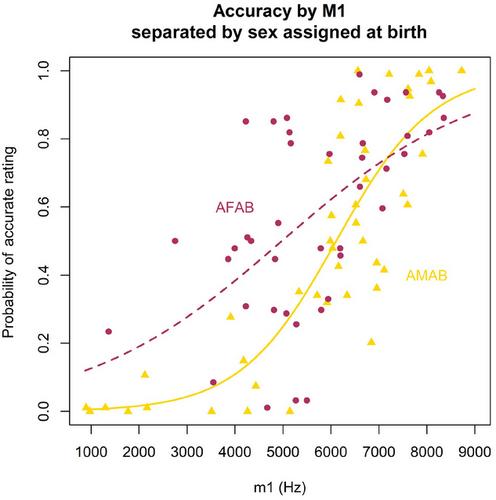Gender and age biases in the assessment of speech accuracy: A study of speech-language clinicians’ ratings of /s/ accuracy
Abstract
Purpose
Typically developing children assigned male at birth (AMAB) and children assigned female at birth (AFAB) produce the fricative /s/ differently: AFAB children produce /s/ with a higher spectral peak frequency. This study examined whether implicit knowledge of these differences affects speech-language pathologists’/speech and language therapists’ (SLPs’/SLTs’) ratings of /s/ accuracy, by comparing ratings made in conditions where SLPs/SLTs were blind to children's sex assigned at birth (SAB) to conditions in which they were told this information.
Methods
SLPs (n = 95) varying in clinical experience rated the accuracy of word-initial /s/ productions (n = 87) of eight children with speech sound disorder in one of four conditions: one in which no information about the children was revealed, one in which children's SAB was revealed, one in which children's age was revealed, and one in which both were revealed.
Results
Despite there being no statistically significant differences between AFAB and AMAB children's /s/ production in researcher-determined accuracy or in one acoustic characteristic, spectral centroid, SLPs in all four conditions judged the /s/ productions of AFAB children as more accurate than AMAB children. Listeners were significantly less likely to judge the productions of AMAB children to be inaccurate in the conditions in which age or age and SAB were revealed. These effects were consistent across SLPs with greatly varying levels of clinical experience.
Conclusion
Knowing or imputing children's age and SAB can affect ratings of /s/ accuracy. Clinicians should be mindful of these potential effects. Future research should understand how expectations about sociolinguistic variation in speech affect appraisals of their speech and language.
WHAT THIS PAPER ADDS
What is already known on the subject
- Adult men and women produce /s/ differently. A consensus is that these differences reflect sociolinguistic gender marking, rather than being the passive consequence of vocal-tract differences. Recent studies have shown that children assigned female at birth (AFAB) and those assigned male at birth (AMAB) produce /s/ differently in ways that mirror the differences between adult men and women, and which presumably reflect gender marking.
What this paper adds to existing knowledge
- We asked whether US-based speech-language pathologists' (SLPs) ratings of the accuracy of /s/ differ depending on whether they are rating an AFAB or an AMAB child, and whether these differences are greater in conditions in which people are told the sex assigned at birth of the child being rated. We found that SLPs were more likely to judge AFAB children's /s/ productions to be more accurate than AMAB children's, even though the productions from the AMAB and AFAB children that were used as stimuli were matched for accuracy as determined by trained researchers.
What are the clinical implications of this work?
- SLPs/speech-language therapists should be sensitive to the influence of social variables when assessing /s/. SLPs/speech-language therapists might rate children's productions differently depending on whether they believe they are rating an AFAB or an AMAB child.


 求助内容:
求助内容: 应助结果提醒方式:
应助结果提醒方式:


